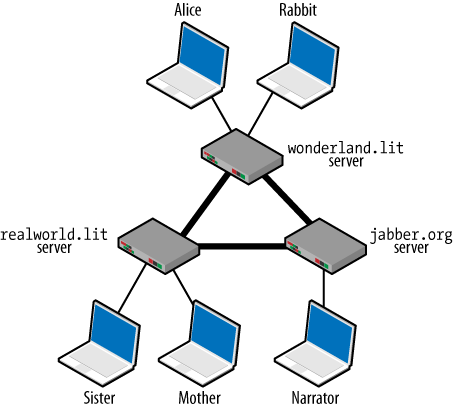XMPP 101
Before diving into the details of XMPP implementation testing, let’s first have a quick crash course about how XMPP works.
The XMPP network consists of a series of interconnected servers with
clients connecting to them, as shown in Figure 7-1. The job of XMPP is to route small
“packets” of XML between these entities on the network. For example,
Alice, who is connected to the wonderland.lit server,
may want to send a message to her sister, who is connected to the
realworld.lit server. To do that, she puts her message
into a small snippet of XML:
<message from="alice@wonderland.lit/RabbitHole"
to="sister@realworld.lit">
<body>Hi there</body>
</message>She then delivers this message to her server, which forwards it to
the realworld.lit server, which in turn delivers it to
her sister’s client.

Figure 7-1. The decentralized architecture of the XMPP Network; clients connect to servers from different domains, which in turn connect to each other
Every entity on the XMPP network is addressed using a Jabber ID (JID). A JID has the form
username@domain/resource,
where domain is the domain name of the XMPP
server and username identifies an account on
that server. One user can be connected to the server with multiple
instances of a client; the resource part of the JID gives a unique name to every connected instance. In some cases, the resource part can be left out, which means the server ...
Get Beautiful Testing now with the O’Reilly learning platform.
O’Reilly members experience books, live events, courses curated by job role, and more from O’Reilly and nearly 200 top publishers.

